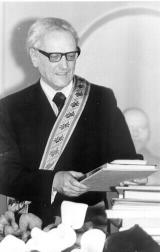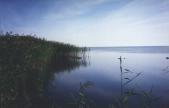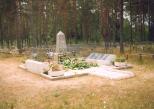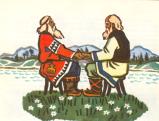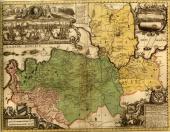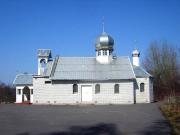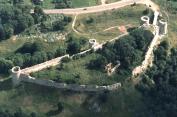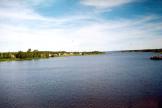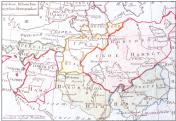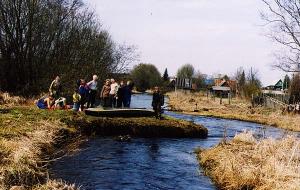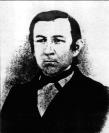Articles
/
Vod (Votes)
Vod (Votes)
Subject /
Ethnic culture/Ethnic communities
Subject /
Ethnic culture/Ethnic communities/
Subject /
Ethnic culture//
Votes (IN FORMER TIMES - Chud (Chudes), their own native name is Vad'alain (Vadjalain)) are an ethnic community, descendants of the ancient inhabitants of the Northwest of Russia. The Votic language is related to the Baltic-Finnic subgroup of the Finno-Ugric branch of the Uralic language family. It's close to the Estonian language. Votes stood apart from Estonian tribes in c. 1000 AD; they were first mentioned in Russian chronicles of 1069. The land of Votes was a part of the Veliky Novgorod (see Vodskaya Land (Land of Votes). Since the 12th century the Orthodoxy began to spread; at the same time some vestiges of heathen beliefs (similar to Izhorsky ones; see Izhora) were remained till the 20th century. On the basis of archeological finds there are three groups of Votes singled out: northwest group (Nizhneye Poluzhye); northeast group (environs of Koporye), south group (environs of Gdov; the one had been assimilated by the Slavic by the 18th century). According to the population census in 1926 there were about 700 Votes (according to the data of the researchers there were more than 6 thousand ones) on the area of the Nizhnyaya Luga river and on the area of Kotly village and Koporye village (now it's Kingisepp District and the west of Lomonosov District). In 1980s Votes were recognized as a disappeared nation. According to the census in 2002 in Russian Federation there are 73 Votes (including 12 people living in the Leningrad Oblast and 12 pople living in S.Petersburg). According to the estimate of the researchers now in the Leningrad Oblast some scores of Votes live (they are mainly old people living in Krakolye village and Luzhitsy village of Kingisepp District). The traditional occupations of Votes were farming, animal husbandry, fishing. The ancient home of Votes (like the Estonians have too) was so-called "zhilaya riga" ("a dwelling threshing barn") - a place used both for living and for drying sheaves. Later, under Russian influence they began to build the houses (izbas) of the East Slavic type having an oven. In the 19th there was a difference between the clothes of single girls (they wore high-necked white sarafans without sleeves, small round caps "pyayasie" decorated with glass beads, kauri shells, tin pendants) and married women (they wore blue sarafans, headgears of conical form made of linen on the hard foundation - "paikas"; before giving birth to a baby they had to wear a white headgear, after that they wore a red one). In the 18th century the married women had their hair shaved; but till the end of the 19th century they had them cut shortly. In the 19th century Russian safafans and headgears like a soroka and povoinik were spread. The men's clothes didn't already have any specific traits. The folklore of Votes was kept and written down (it is presented by tales, songs, lamentations, proverbs, riddles); the kannyl, a string musical instrument, was well-known (see Kantele). The objects of Votes' culture are presented in the exposition of the local history museum of Kingisepp. In Luzhytsy village there is a private museum of Votes' folklore (the founder of the museum is T.V.Yefimova). Since 2000 in July the folk festival of the village has been held. The folk groups of Kingisepp District take part in the festival.
Authors
Chistyakov, Anton Yuryevich
Persons
Yefimova, T.I.
Geography
Neighbouring Territories/Pskov Oblast, the/Gdov Town
Leningrad Oblast, the/Lomonosov District/Koporye Village
Leningrad Oblast, the/Kingisepp District/Kotli Village
Leningrad Oblast, the/Kingisepp District/Krakolye Village
Leningrad Oblast, the/Kingisepp District/Luzhitsi Village
Topographical landmarks/Nizhneye Poluzhye
Historical Toponyms/Veliky Novgorod/Vodskaya Pyatina ("Fifth")
Bibliography
Мы живем на одной земле: Население Петербурга и Ленинградской области. СПб., 1992, С. 71-88
Прибалтийско-финские народы России. М., 2003., С. 555-591
Rank G. Vatjalaiset. Helsinki, 1960, С. 555-591
Ariste P. Vadja rahvakalender. Tallinn, 1969, С. 555-591
Subject Index
Holiday of Luzhitsa Village
Kingisepp Museum od the Local History, the
Vod Museum, the
Mentioned in articles:
|
hidden
|
Ariste, Paul, (1905-1990), a scholar
Paul Ariste (1905-1990) was a linguist, ethnographer, Doctor of Philology (1939), academician of the Academy of Science of Estonian SSR (1954). In 1927 he changed his surname Berg for Estonian one - Ariste (by the name of the village and gulf of... more
|
|
|
|
hidden
|
Burial grounds of the Vod people.
Burial grounds of the Vod. Funeral sites of the North-western Vod ("Chud") were explored by E.A. Ryabinin in 1983-1988 in the former Vod parish of Kattila (Kotli Village of the Kingisepp district). The oldest type is presented by stone burial... more
|
|
|
|
hidden
|
|
hidden
|
Chudskoye Lake
LAKE CHUDSKOYE (obsolete: Peipus, Est. Peipsi jarv.) It is located in Estonia and Russian Federation (Pskov Oblast; in Leningrad Oblast, a small portion in Slantsi District.) The lake constitutes a common body of water with Lake Pskovskoye, to... more
|
|
|
|
hidden
|
Ethnic deportations
Ethnic deportations are forced resettlement carried out according to an ethnic signs. In 1935-36 in the Leningrad Oblast there were some activities on purging the zone of land with 22 kilometres wide at the border with Finland "from kulak and... more
|
|
|
|
hidden
|
Ethnic groups if the Leningrad Oblast
Ethnic communities of the Leningrad Oblast. The settled communities of people historically formed on the certain territory, having the common features of culture and self-consciousness expressed in the native name are called an ethnic community (or... more
|
|
|
|
hidden
|
Finno-Ugric nations
Finno-Ugric nations are ethnic communities speaking the languages of the Finno-Ugric group which is a part (together with the Samoyedic and Yukaghir groups) of the Ural (Uralic-Yukaghir) language family. Finno-Ugric nations have lived historically... more
|
|
|
hidden
|
Folklore
FOLKLORE of folks living in the Leningrad Oblast (ref. Ethnic communities in Leningrad Oblast) is multilayer polyethnic heritage which appeared as a result of rich history of the region. One of the first people to study the Veps in the period of... more
|
|
|
|
hidden
|
Ingermanlandia
INGERMANLANDIA (Swed. Ingermanland, Rus. Izhora Land or Ingria), historic and cultural region in the western part of the Leningrad Oblast (Kingisepp, Volosovo, Lomonosov, Vsevolozhsk, Gatchina, Tosno, western part of Kirovsk Districts.) The western... more
|
|
|
|
hidden
|
Kingisepp District
KINGISEPP DISTRICT, a part of Leningrad Oblast. Population: 74,300, of which, 52,100 live in the adm. center Kingisepp Town. Area: 2842.1 sq. km. It has 191 rural settlements. It was established in 1927.It borders with Lomonosov, Volosovo, and... more
|
|
|
|
hidden
|
Koporye Fortress
Koporye Fortress (village Koporye, on the bank of the river Koporka) is located on the top of the rock which surrounded by valley of the river and ravines. It is located 12 km from the Gulf of Finland. The fortifiers were attracted the convenient... more
|
|
|
|
hidden
|
Population
Population. According to the census of 2002 in the Leningrad Oblast there were 1669,205 thousand people; according to the estimate made on 1 July 2005 there were 1647,6 thousand people including the town dwellers numbering 1093,9 thousand people... more
|
|
|
hidden
|
Russians
Russians are an ethnic community, the main population of the Russian Federation. Among Russians there are some ethnic groups and ethnographic groups can be marked (e.g. Cossacks and Pomors (coast-dwellers (inhabitants of White Sea and Barents Sea... more
|
|
|
hidden
|
Singers of runes
Singers of runes (in Finnish - runonlaulajat) are performers of folk poetic works at the Baltic-Finnic nations (Karelians, Izhora, Votes, Veps), narrators of folk tales (in Finnish runo is a poem, rune). The repertoire of the singers of runes... more
|
|
|
hidden
|
Ust-Luga, settlement
UST-LUGA, a settlement in Kingisepp District. Population: 1990; apart from the Russians, Izhora and Vod families live in U.-L. and its environs. Located in the mouth of the Luga River. Adjacent to U.-L. is Krakolye village. The settlement appeared... more
|
|
|
|
hidden
|
v. Sankt-Peterburg Gubernia, the
ST. PETERSBURG GUBERNIA, historic adm. and territorial unit of Russia. Established in 1708 by the decree of Peter I subdividing Russia into eight gubernias. It included the areas of the current Leningrad, Novgorod, Pskov, and Tver Oblasts, and... more
|
|
|
|
hidden
|
Vodskaya Land
VODSKAYA LAND (Votskaya Land), historic, cultural, and administrative region of the middle-age Rus, located in the north-western part of Veliky Novgorod’s lands (western part of the current Leningrad Oblast.) First mentioned in the chronicle c.... more
|
|
|
hidden
|
Volosovo District
VOLOSOVO DISTRICT, a part of Leningrad Oblast. Area: 2680.5 sq. km. Population: 46,900. Adm. center: Volosovo Town. The district comprises Kikerino urban settlement, and 202 rural localities. It borders Kingisepp, Lomonosov, Gatchina, and Luga... more
|
|
|
|
hidden
|
Yevropeus, Daniel (1820-18884), a scholar
David Emmanuel Daniel Europaeus (in Finnish - Taneli; in Russian - David Petrovich) (1820-1884) was a folklorist, archaeologist. Ethnographer. He was born in the family of a pastor in Olkkola Farmstead of the parish of Savitaipale of the Vyborg... more
|
|
|
|
hidden
|
|
hidden
|
|
hidden
|
|
hidden
|
|
hidden
|
|
hidden
|
|
hidden
|
|
hidden
|
|
hidden
|
|
hidden
|
|
hidden
|
|
hidden
|
|
hidden
|
|
hidden
|
|
hidden
|
|
hidden
|
|
hidden
|
|
hidden
|
|
hidden
|
|
hidden
|
|






